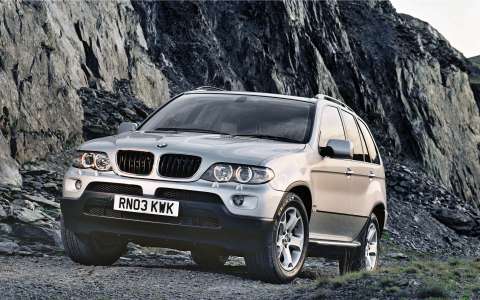 2004 BMW X5 3.0i 3.0d 4.4i 4.8is |
 2004 BMW X5 3.0i 3.0d 4.4i 4.8is |
 2004 BMW X5 |
23rd January, 2004The New BMW X5 Range Arrives in Australia
Now Smarter Than Ever – in every sense BMW’s benchmark-setting X5 Sports Activity Vehicle has been significantly improved for 2004 adding new engines, a new driver-oriented all-wheel drive system, xDrive, as well as bearing a striking new look. The revised X5 is tipped for even greater success in Australia with even greater appeal than before. On sale from February, the V8-powered 4.4i gains a new 235 kW engine, while the 3.0d turbo-diesel model is enhanced by a second-generation common rail fuel injection system to provide a giant hike in power and torque. The 150 kW 3.0-litre six-cylinder turbo-diesel engine produces V8-style torque: 480 Nm between 2,000 rpm and 2,750 rpm. All six-cylinder models gain six-speed manual transmissions while the V8 and turbo-diesel 3.0d gain a new six-speed ZF automatic Steptronic transmission. Arriving in Australia mid-year, following a preview at the Melbourne Motor Show in February, is the fire-breathing X5 4.8is, a super car for the road and track, featuring a new 4.8-litre, 265 kW V8 engine, capable of rocketing the X5 to 100 km/h in about six seconds, and on to a tarmac-melting top speed of 246 km/h. The supremely powerful 4.8is is naturally aspirated for instantaneously responsive acceleration. A modified inlet and exhaust system and a new engine management program underline the depth of the engineering enhancements. The exclusive 4.8is will be available only in limited numbers, and features a subtle body kit incorporating a unique front air dam. It promises to be even more exhilarating than the previous 4.6is’ benchmark-setting performance, thanks partly to having its chassis honed at the famed Nürburgring circuit. From launch in Australia in November 2000, the phenomenally successful, sporting and luxurious X5 Sports Activity Vehicle created a new segment in the 4WD market, and has dominated sales in this increasingly competitive sector. In 2003, according to industry statistician VFACTS, the BMW X5 sold 2,506 vehicles, representing a 21% share of the luxury sports utility vehicle segment. This is an increase on the 2002 result of 2,238 units, which is a significant achievement in the face of a more competitive market environment. BMW Group Australia expects the specification improvement, subtle styling improvements and exceptionally high levels of standard equipment will support the X5’s continued dominance of the top end of the large luxury all-wheel drive market. The new intelligent, infinitely variable xDrive all-wheel drive transmission system puts the driver in control in all conditions, on or off-road thanks to excellent driving dynamics and superlative traction. Able to provide up to 100 percent of the drive to the rear or vary the torque between axles means the potential for understeer and oversteer can be prevented and secure traction maintained during fast cornering. Drawing data from wheel sensors as well as the Dynamic Stability Control system, xDrive considers yaw rate, vehicle speed and steering angle when splitting drive torque between axles, thus minimising the chances of oversteer in bends. By managing the drive split between axles intelligently, DSC cuts in much later than competitor systems, so as not to diminish driver enjoyment. Lightning fast reaction to the multitude of data inputs enables xDrive to cut wheelspin and assist stability. The xDrive system works as well on low-grip surfaces, such as during step-off on icy roads, as it does when attacking rough, twisting mountain roads. In addition to the new mechanical hardware, all V8-powered models adopt Adaptive Headlights, combined with more powerful Bi-Xenon lamps, which allow drivers to see around corners. The X5’s new muscular 4.4-litre V8 engine is adapted from the 7 Series and develops 235 kW (up 25 kW) thanks to VALVETRONIC electronic timing control, Bi-VANOS and a fully variable intake system. It races from rest to 100 km/h in just 7.0 seconds (0.5 seconds faster), and on to a top speed of 240 km/h (with optional Sport Package), while ECE fuel consumption tests reveal an impressive reduction in fuel consumption of almost one litre per 100 km to 13.1 l/100 km. The six-cylinder 3.0i petrol engine X5 is unchanged aside from the addition of a standard six-speed manual transmission. Fuel economy improves as a result of the more closely stacked ratios. The sporty, powerful 3.0d straight six turbo-diesel engine, launched in Australia in March 2003 has been further enhanced and is sure to continue as a major drawcard for the X5 range. Equipped with its second-generation common rail fuel injection the more powerful 3.0d engine is 1.7 seconds faster in the charge to 100 km/h than previously (now 8.8 seconds) and as fast as the petrol-powered 3.0i. Fitted with the new turbo-diesel engine, BMW Group Australia is confident the more powerful and marginally more frugal 3.0d will continue to account for in excess of 30 percent of all X5 sales. All models gain a purposeful revision to the front end metal work as well as new style headlamps and new bumpers and air dams. At the rear, new look tail lights are complemented by a soft-close function for the upper portion of the tailgate, while the new rain sensor is coupled to automatic headlight control whereby the vehicle’s lights are automatically activated in low light and low visability. Inside, a new standard colour option for the Dakota leather is Truffle Brown, while three new optional Nappa leather trims are offered, Light Beige, Lava Grey and Black. A new range of 17-inch and 18-inch light alloy wheel designs will also be introduced, along with new 19-inch rims for customers optioning the Sport Package. The new X5 benefits from an innovative trailer stabilisation feature linked to the Dynamic Stability Control system. This employs sensors to detect swaying that can cause loss of control and then applies the brakes to ensure vehicle stability. Confirming BMW’s original design and safety philosophy, the X5 scored a maximum Five Stars in the world’s toughest independent crash test conducted by the European New Car Assessment Programme. Previously acclaimed as ‘the best car ever tested’ by the American Insurance Institute for Highway Safety, and the critics’ choice for its engaging driving dynamics, the X5 received the ultimate recognition for occupant safety. Standard active safety features on all models include Automatic Stability Control and Traction (ASC-X), Dynamic Stability Control (DSC-X), Anti-Lock Brakes (ABS), Dynamic Brake Control (DBC), Automatic Differential Brake (ADB-X), Hill Descent Control (HDC), and Corner Brake Control (CBC). Standard passive safety features include 10 airbags fitted to all Australian specification X5 models as standard; dual front, four side, and four front and rear head airbags. As with all BMW Group Australia vehicles, Data Dot security is also standard. “The insatiable global appetite for the BMW X5 is undoubtedly due to its combination of luxury and power, its driving pleasure both on and off-road,” said Dr Franz Sauter, Managing Director of BMW Group Australia. “The BMW X5 set the benchmark for this class and dominated the market since launch. We are convinced the new X5 will continue to strike a chord with buyers who enjoy driving, especially now we have enhanced our turbo-diesel and V8 engines.”
NB: Sport Package optionally available on 3.0i, 3.0d and 4.4i models |